Home › Forums › Fantasy › General Fantasy › Irregular Warhammer Lore
- This topic has 87 replies, 15 voices, and was last updated 1 year, 3 months ago by
 Angel Barracks.
Angel Barracks.
-
AuthorPosts
-
23/12/2022 at 09:54 #181460
 Angel BarracksModerator
Angel BarracksModeratorQuickening
The Quickening is the term used for when a Human boy or girl reaches puberty. In most provinces, this is the time in which the child becomes an adult, which is also accompanied by the child’s Dooming, although this is not always a guarantee they’ll receive the full responsibilities and rights granted to someone older. In theory, it is at this point in which he or she is eligible to become a craftsman’s apprentice, join the military, or become a priest. In reality, many children begin their training in their given vocation long before this point, learning at the knees of their parents and others within their community.
The Quickening ceremony varies from province to province, but it often involves a small celebration with friends and family, where the new adult is presented to the Gods and to those attending. An article of clothing, toy, or other item that belonged to the child is ritually burned or buried, to symbolise his or her passage into adulthood. Another common practise is to divide up the young men and women of a settlement, then allow them to “choose” their future spouse (often at the prodding and advice of their parents). Although considered a time of joy for the adults, the event is usually dreaded by the pubescent youth as a horribly embarrassing affair. Depending on the area, these matches are either considered binding oaths or the “couples” are allowed to change their mind within a certain period of time, typically until the next time Mannslieb is full.
In the wilder areas of the Empire, particularly the far north, the fringes of Talabecland, and Ostland, boys are taken away by their elders and undergo a rigorous initiation in which they must hunt and gather their own food and prove their skills with weapons. Not all survive this initiation, and it is common practise for these lost children’s names to be stricken from memory.
26/12/2022 at 10:48 #181534 Angel BarracksModerator
Angel BarracksModeratorSigmartag
The festival of Sigmartag celebrates Sigmar’s ascension to the heavens as a god. Held on the 18th of Sigmarzeit, it also marks the first day of summer. Throughout the Empire, work ceases and citizens feast, drink, and sing. Sigmar’s exploits are recounted in tales and plays. Consumption of the intimidating ‘Sigmar’s Sausage’ is central to the celebrations. Those who manage to eat a whole sausage in a single sitting are promised strength and vigour for the rest of the year.
The most magnificent celebrations take place at the High Temple of Sigmar, presided over by the Grand Theogonist, and attended by the Emperor. Thousands crowd outside the temple to partake in the holy liturgies. The festival culminates with spectacular pyromantics organised by the Bright College (though many priests of Sigmar boycott this display).
There are various holy days devoted to Sigmar throughout the year, marking events of Sigmar’s life such as the rescue of King Kurgan Ironbeard, the Battle of Black Fire Pass, and his coronation. Dwarfs, as the allies of Sigmar, are honoured on such festival days with gifts of food or drink presented to them by passing strangers.
A major festival in Altdorf marks the accession of the first Grand Theogonist, Johann Helsturm. On the 33rd of Sigmarzeit, Sigmarite priests parade Helstrum’s gilded skull and his sacred mace through the capital’s crowded streets.
27/12/2022 at 11:43 #181542 Angel BarracksModerator
Angel BarracksModeratorOwt in shaden wodespan, dwelt the murdrus beaste,
Vittalling on the sack-for-homes, gorge-laden with his feaste.
Stalkering ‘tween the leafen glade, preying ‘pon the weake.
Glutting the hardy and the poor, e’en dinning on the meake.
And noth there was, that brave the woode,
Noth amidste the sword-handy and the goode,
‘Cept a gallanting Knacht from far Breton,
Who trot a-quest to lay sword on.
And kinder Tomas Wanderer, ‘nored his mother’s tongue,
For Tomas he listened nither, much so for kinder yonge.
He hitched up sweepstik ponie, waving woden sworde,
And sleeked out to the wodespan, footstepping Breton Lord.
The snilvin Foole pranced at the bridge, and cry cackle a the boye,
“Go sleekin not with Beast of Teeth, not slitblood with some toy.”
But he was the Foole & none to mind, and Tomas heeded not,
Slung saddleshrag on destrier and westered at the trot.
Yonge Tomas spied the girthen oak and tarried there a while,
Then ‘stead of easting back again, Tom rid another mile.
He cleft the black leafe shabbery and swaydin blood-daubed vine,
Carefree took forth with knapper-foode, and fettered there to dine.
The wodecutman found Tomas there, thrice spanned him ’round the ear
“Be fangs and claws for you, my ked, if sunfall shrouds you here.”
With axehaft brunting younge man’s hide, the wodesman bade Tom home,
But Tomas mere a squallsome ked, and so he bid to roam.
Onnerin and inneron, through garbled bole and thresy twine,
Tomas goaded stick-horse on, as ruddy sun wed pale moonshine.
And there aminst the sprickly bushe, he spied the lairing of the brute,
Stepped out brightly ‘pon his steed, thru’ graping branch & scraping root.
And there bale-eyed the spiten Beaste, all goried horns, and slives and fangs,
Yet brisky Tomas ventured on, he couched no dread, nor homeward pangs.
Though brave Knacht bidden to the grave, with woden sword aloft
Plucky Tom brandished at the Beast, who marred him with a scoff.
“What mires you here, younge smoothskin-born?
Did not your mother about me warn?”
“I have no fear! Tom cried aloud,
Horsing forward ’til Beast he growled.
“I shall wolfe your flesh and snap your bones,
Skrind your folk and burne their homes.
For mocking ked to dare my rage,
Your jibe it traps me like a cage.
The unclaimed ones must dread my kinde,
Can never squander fear behind.”
So Tomas Wanderer was no more, who never did no goode.
So remember poor Tomas, and roam not in the woode.
-Tomas Wanderer, Empire nursery rhyme
28/12/2022 at 10:18 #181562 Angel BarracksModerator
Angel BarracksModeratorMorr
Morr is the god of the dead, prophecy, dreams, and dreamers in the Old World Pantheon. He holds sway over illusions and all things that are not what they seem. A contemplative god, Morr guards the souls of the departed from absorption by Chaos and unholy use by necromancers, just as his priests guard the corpses buried in the Gardens of Morr, and protects the dreams of the sleeping from Daemons that would pervert them.
Morr and his devoted followers are the eternal enemies of the Undead, and guardians against grave and tomb robbers. The Cult of Morr is not a popular one, but is of singular importance in the religious life of the Old World, for all come to Morr’s gate eventually
Morr is one of the Old Gods later absorbed by the Classical Pantheon of ancient Tilea. Some myths hold that Morr is the husband of Verena, the goddess of knowledge, brother of Khaine, the god of murder, and father of Myrmidia, the goddess of war and Shallya, the goddess of healing and mercy. He is usually depicted as a tall, aristocratic Human male with dark hair and an aura of intensity and sometimes as a faceless figure draped in a deep, black hood and cloak carrying a scythe.
The most popular symbols of Mórr are the raven, the portal and the hourglass. His clerics all wear plain black hooded robes, without any symbol or adornment.
“Saved by Morr,” is a way to say “dead” by folk in the Empire. At the same time, “Morr damn you!” is a popular Imperial expletive.
29/12/2022 at 09:26 #181602 Angel BarracksModerator
Angel BarracksModeratorThe Cauldrons of Blood are rumoured to be gifts from Khaine, who bestowed them upon the Witch Elves as rewards for their single-minded dedication to his cause — at least that was Morathi’s claim when she gave the first of these brass cauldrons to the Cult of Khaine. Each is kept filled with the blood of countless sacrificial victims, though curiously, it never overflows. The cauldron always maintains the same level, no matter how many gallons of lifeblood are poured into it, as though the very metal of the cauldron thirsts.
Each Cauldron of Blood lies heavy with dark enchantments and, with the proper knowledge, a Death Hag can access these to unleash the many blessings of Khaine. Chief of these is the cauldron’s ability to restore youth and vitality to those who bathe within it. As Morathi kept the innermost secrets of the cauldron to herself, all others who utilize this blessing must frequently repeat the bathing process or soon find themselves in their old and withered states once more. In this way, the Hag Sorceress ensures the Witch Elves’ loyalty — with the irresistible lure of eternal beauty.
The Cauldrons of Blood are ordinarily kept safely secured within the great temples of Khaine, but one is occasionally brought forth when a great host of Witch Elves marches to battle. Drawn to the cauldron by the prospect of slaughter, the Lord of Murder’s baleful spirit goads nearby Dark Elves to a feverish war-lust that will be spent only when there is no longer any blood to spill.
My 10mm take:
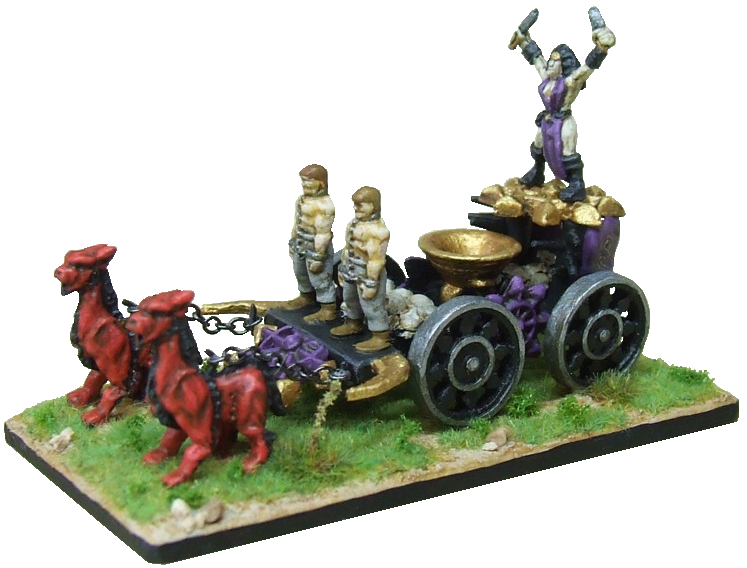
Official GW version:
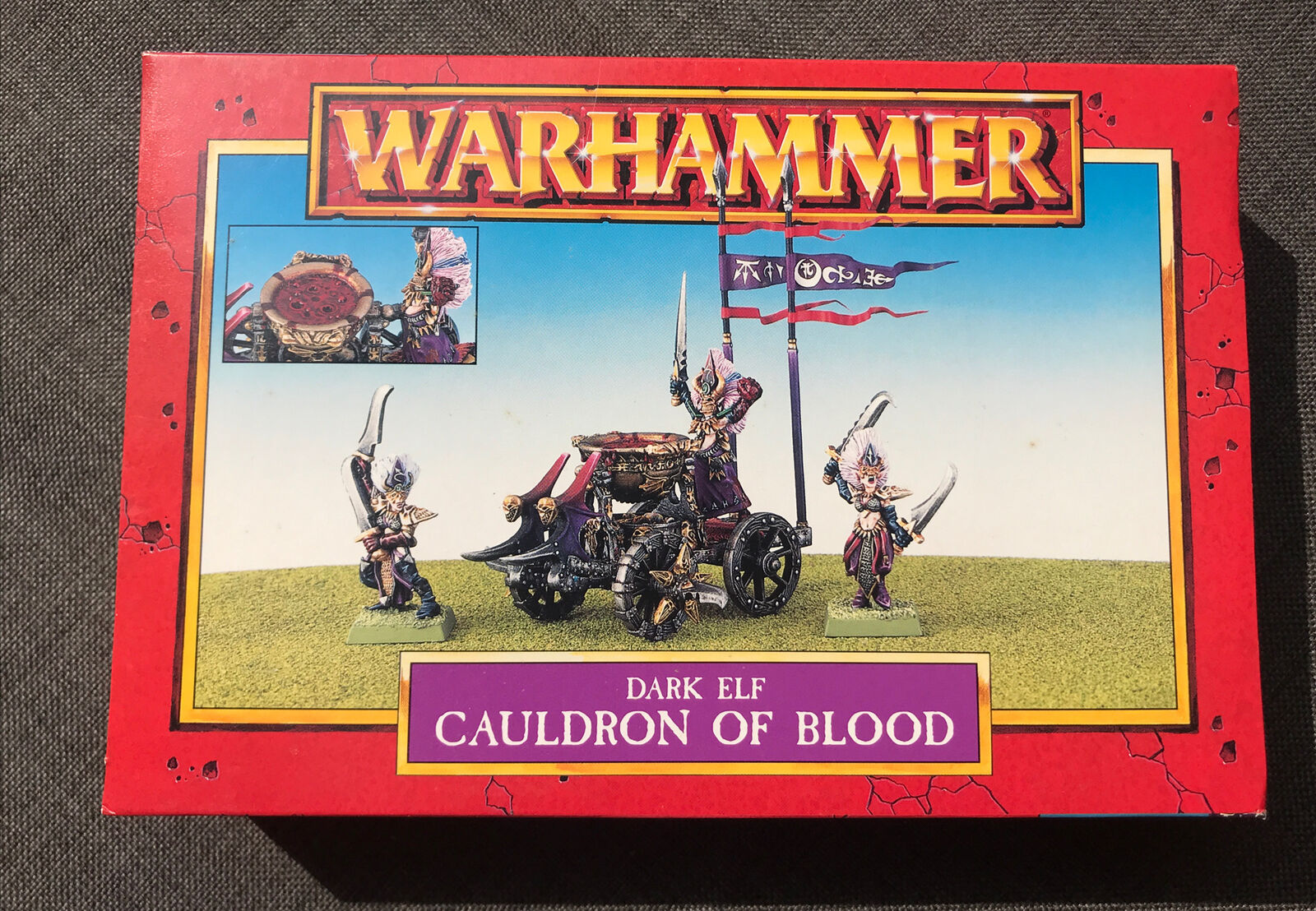 30/12/2022 at 09:49 #181652
30/12/2022 at 09:49 #181652 Angel BarracksModerator
Angel BarracksModeratorThe Imperial Cross, also sometimes called the Cross of Sigmar, is the symbol most commonly used to represent the Empire as a whole. It is also a commonly used sigil for the most important Imperial deity, Sigmar Heldenhammer, who was the mortal founder of the Empire.
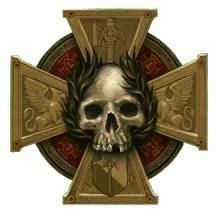
The Imperial Cross is a long-standing symbol of Imperial unity. The top three arms of the cross stand for the northern, western, and eastern tribes of Men who joined together under the leadership of Sigmar to forge the ancient Empire in the face of the myriad threats that faced Humanity in the region, and the bottom refers to the Dwarfs, the Empire’s oldest and staunchest allies.
This sigil has connotations of unity and oaths fulfilled. The Imperial Cross is often inscribed on official documents issued by the emperor or by one of the Elector Counts and is also a popular icon displayed on the banners of Imperial and Sigmarite armies.
02/01/2023 at 10:53 #181772 Angel BarracksModerator
Angel BarracksModerator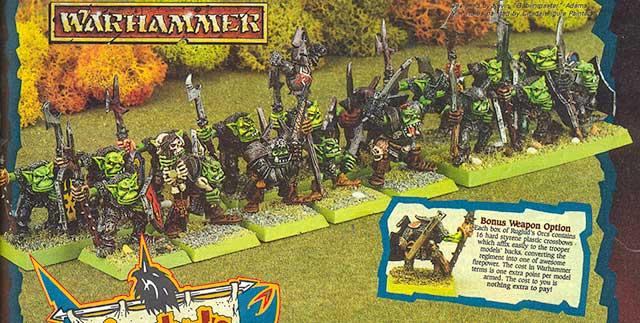
The Story of Ruglud’s Armoured Orcs
The Crooked Eye Orcs had travelled many miles westward to the Old World, suffering the sniping of mountain Goblins, incessant rain, and the endless whining of Bambrag, their incontinent shaman.
Once, they skirted a ruined Dwarfhold. Fear of spirits kept them from sheltering inside, but, a single Orc Hero named Ruglud had dared to enter. He returned unharmed, but had not spoken since, and stated blankly into space.
The Orcs huddled in the rain before a rough stone wall across a narrow pass, while Chief Gudruk Bonechewer yelled at a figure on the battlements.
‘Stoopid!’, he screamed, ‘Do we look like Chaos boys?’
‘Zog off!’ echoed the reply.
Gudruk returned to the tribe, dodging the hall of stones and garbage that accompanied this witty riposte.
‘Lissen,’ he said. ‘Them kak-‘ead Gobboes reckon the Chaos boys took ev’ryfink over. They ain’t comin’ out an’ they ain’t lettin’ nuffink through. They got bows an’ rocks an’ spears an’ stuff – if we was to try and get ’em, they’d crump us to bits.’ He thought for a while.
‘We needs volunteers’, he announced at length. His warriors developed a sudden and compelling interest in the ground at their feet.
‘Or armour’, whined Bambrag, ‘Couldn’t touch us if we ‘ad cans like real Chaos boys.’
‘We ain’t got cans, ‘ave we, Trickle-legs?’ snarled Gudruk.
‘Cans… jus’ lyin’ where they dropped… all black an’ spiky.’
It was Ruglud who spoke. Gudruk gave him a good shake to speed the recovery of his senses, and he continued dreamily.
‘Down this Stunty-hole… lotsa rooms … lost… big room… big enough to stand up in … big pile of bones an’ gear… spiky Stunties an’ reg’lar ones… wiped each uvver out…’
‘Yerrrss!’ cried Gudruk, ‘We’ll ‘ave some o’ that! Come on, boys – it’s Goblin-gizzard for supper!’.
A swift expedition returned to the Dwarfhold. The ill-fitting plates were roughly hammered into shape and held
together with whatever came to hand. By nightfall, a small unit of armoured warriors was ready.
As the gear’s discoverer and the bravest, meanest and certainly the most stupid Orc, Ruglud was made leader, At Gudruk’s suggestion, Bambrag became the regimental musician on the Xylobone, a traditional Orcish instrument, and Maggot – Gudruk’s youngest and most irritating whelp – joined the ranks as standard-bearer.
The tribe feasted upon Goblin-flesh long into the night – all except for Ruglud, who couldn’t get his helmet off, and was reduced to sucking broth through a straw.
Battlecry – The most frequent battlecry is a repetitive chant of ‘Gobbo fer tea, Gobbo fer tea, Gobbo, Gobbo, Gobbo fer tea!’, with ‘Stunty’, “Uman’ and so on being substituted for ‘Gobbo’ as appropriate.
Deeds – The Commandos’ first victory led to many more as they pushed across the Worlds’ Mountains towards the old World. Most of these were over isolated Goblin strongholds, and are remembered only in the stories and drinking songs of the Crooked Eye Orcs – and then in versions which are probably wildly exaggerated. one confirmed exploit was the storming of Karak-Bazik, an outlier to the great Dwarven settlement of Zhufbar, when the Dwarfs were obliged to abandon the Dwarfhold and cave in a series of connecting tunnels to cover their retreat.
15/01/2023 at 14:48 #182257 Angel BarracksModerator
Angel BarracksModeratorThe Imperial Cross, also sometimes called the Cross of Sigmar, is the symbol most commonly used to represent the Empire as a whole. It is also a commonly used sigil for the most important Imperial deity, Sigmar Heldenhammer, who was the mortal founder of the Empire.
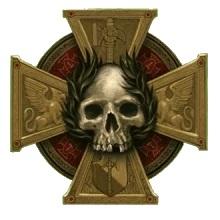
The Imperial Cross is a long-standing symbol of Imperial unity. The top three arms of the cross stand for the northern, western, and eastern tribes of Men who joined together under the leadership of Sigmar to forge the ancient Empire in the face of the myriad threats that faced Humanity in the region, and the bottom refers to the Dwarfs, the Empire’s oldest and staunchest allies.
This sigil has connotations of unity and oaths fulfilled. The Imperial Cross is often inscribed on official documents issued by the emperor or by one of the Elector Counts and is also a popular icon displayed on the banners of Imperial and Sigmarite armies.
-
AuthorPosts
- You must be logged in to reply to this topic.



